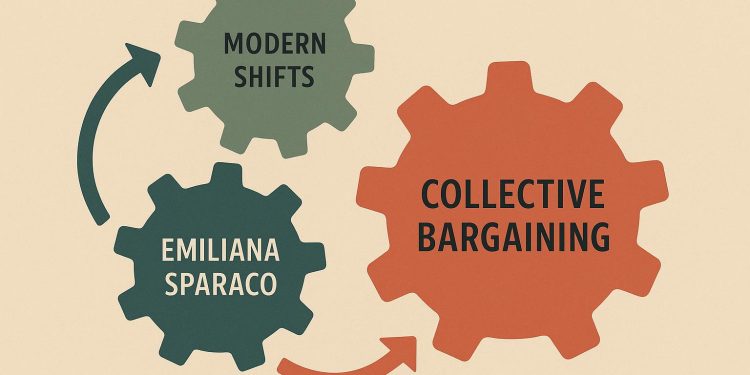Emiliana Sparaco is an experienced labor organizer and representative whose career spans more than twenty years of bargaining, worker mobilization, and leadership development. Emiliana Sparaco has guided employees through organizing efforts, contract negotiations, and workplace campaigns, and she has contributed to policy initiatives that strengthened worker protections. Drawing on her background with SEIU locals, the Fight for 15, and her recent leadership roles with IFPTE, she brings a grounded perspective to discussions of how collective bargaining continues to change. Her work has included developing training programs, coordinating large scale recruitment initiatives, and supporting unions experiencing rapid expansion. She has also volunteered with several community based organizations and completed the Labor Relations Certificate Program at Cornell University. This article places her experience in context with broader trends shaping how workers and employers negotiate in the twenty first century.
The Evolution of Collective Bargaining in the 21st Century
Collective bargaining refers to the process through which employees, usually represented by unions, negotiate with management over wages, benefits, working conditions, and other terms of employment. While the basic idea hasn’t changed much since the industrial era, the practice itself has evolved dramatically in the 21st century.
Technology, globalization, shifting labor markets, and new worker expectations have transformed the way bargaining occurs and its implications for the future of work. Technology has changed communication and organization. In the past, union negotiations took place across a physical table, with limited access to outside information during the process. Today, negotiations often occur in hybrid formats, utilizing video calls, secure online platforms, and real-time data to inform decision-making.
Workers can connect instantly across locations, share strategies through digital networks, and coordinate actions with far greater efficiency than before. It has made organizing easier in some ways, but it has also increased transparency and pressure, as public attention on labor disputes can spread quickly through social media.
Globalization has also changed the terrain. Many industries now operate across borders, with supply chains that depend on workers in multiple countries. That complicates bargaining because decisions made in one region can impact jobs elsewhere. For example, companies can shift production to lower-cost areas, weakening traditional leverage points for unions.
At the same time, global awareness of worker rights has grown. International labor standards, consumer activism, and corporate responsibility campaigns have created new forms of indirect bargaining power. Workers can now appeal not only to employers but also to public opinion and investors who care about ethical practices. This global context has made labor negotiations not only an economic issue but also a moral and social one, tied to how society defines fairness in a connected world.
The workforce also looks different. The rise of gig work, contract labor, and remote jobs has blurred the old lines between employee and employer. Traditional collective bargaining laws primarily targeted factory and office environments, where people typically had stable, long-term employment relationships. Gig workers, freelancers, and other nontraditional employees often lack legal recognition as “employees,” which limits their bargaining rights. In response, new forms of worker organization have emerged. Some groups form associations or advocacy networks rather than formal unions. Others use digital tools to negotiate collectively, even without legal bargaining power, as seen in movements among rideshare drivers and delivery workers.
Employers have also adapted. Many companies now take a more collaborative approach, recognizing that adversarial bargaining can hurt morale and productivity. Concepts such as interest-based bargaining and partnership agreements have become increasingly common, focusing on shared goals rather than zero-sum outcomes. In some industries, labor and management are finding ways to align on long-term sustainability, worker training, and diversity goals.
Looking ahead, the evolution of collective bargaining will continue mirroring broader social and economic changes. Artificial intelligence, automation, and climate transitions continue to reshape jobs, and both workers and employers will need to negotiate on how to adapt. Ideally, negotiations will enable both parties to reach a mutually beneficial compromise.
About Emiliana Sparaco
Emiliana Sparaco is a seasoned labor organizer with more than twenty years of experience in bargaining, worker leadership development, and campaign coordination. She has recruited and mobilized employees in workplace, contract, and political initiatives, and has led negotiations that secured meaningful gains for workers across the United States. Her background includes roles with SEIU locals, the Fight for 15, and recent leadership positions with IFPTE. She has also volunteered with civic and community based organizations and completed the Labor Relations Certificate Program at Cornell University.






